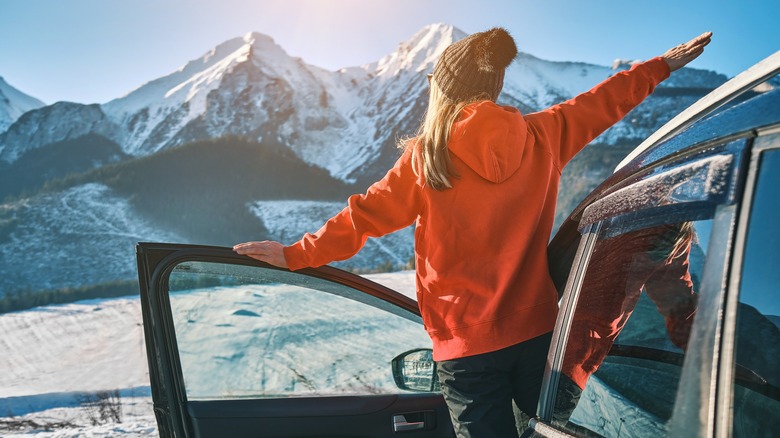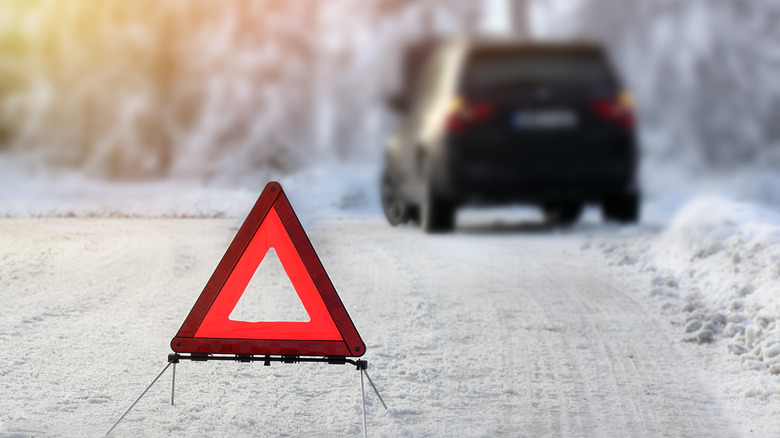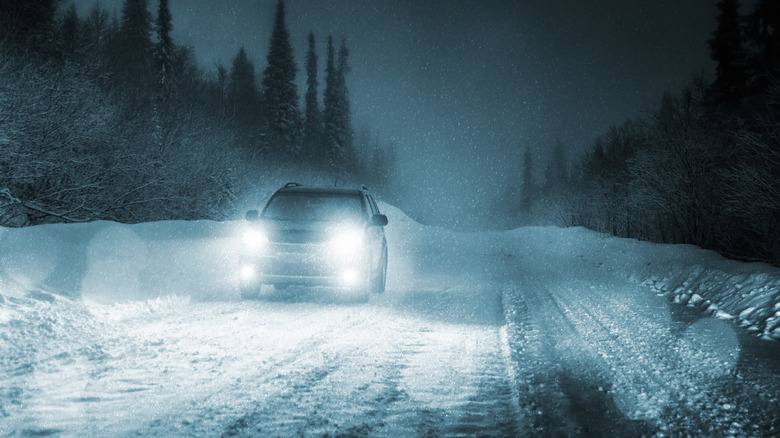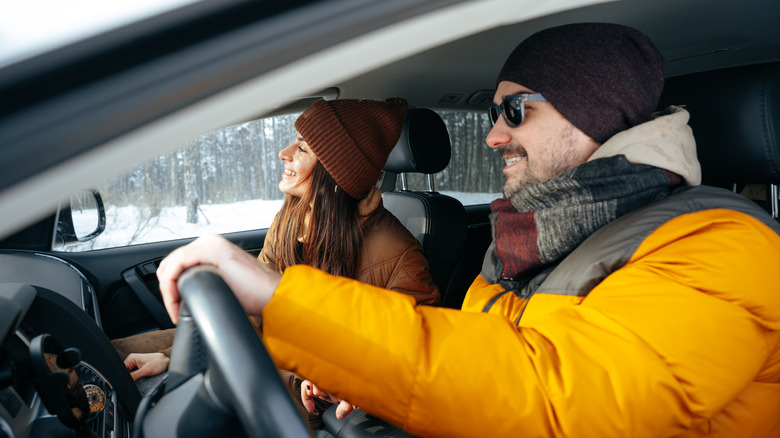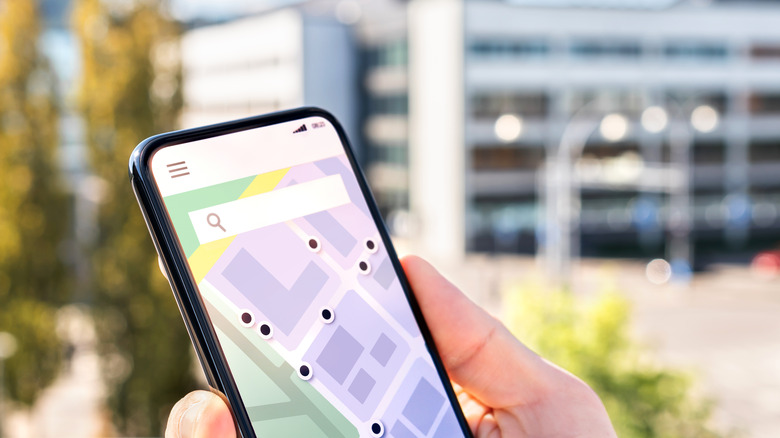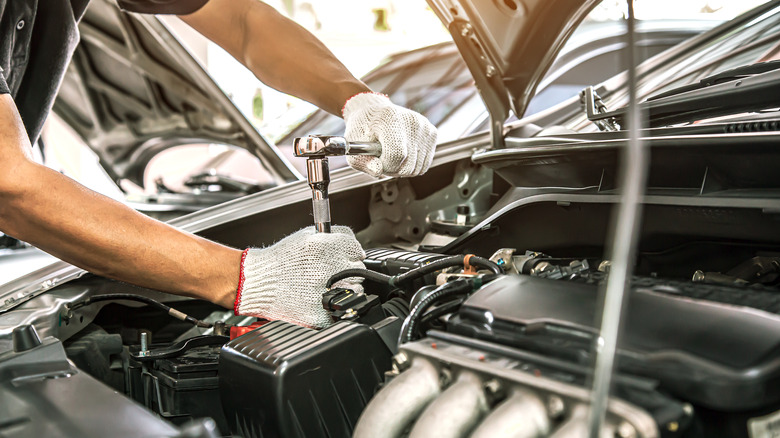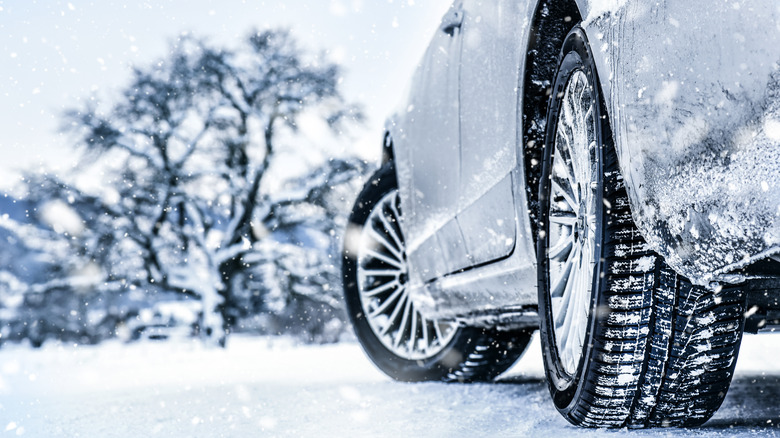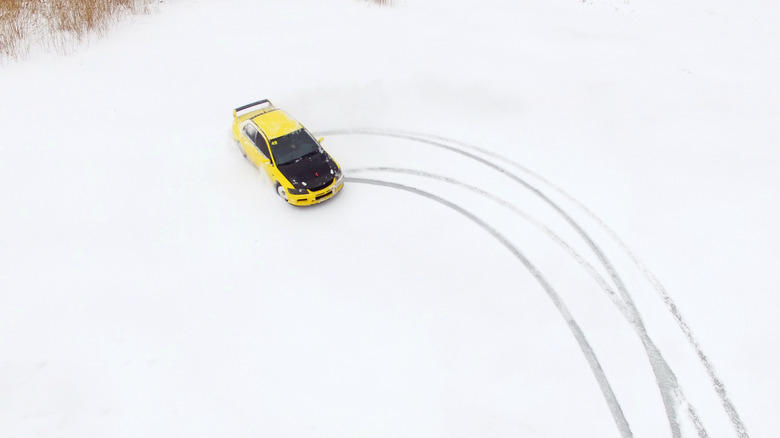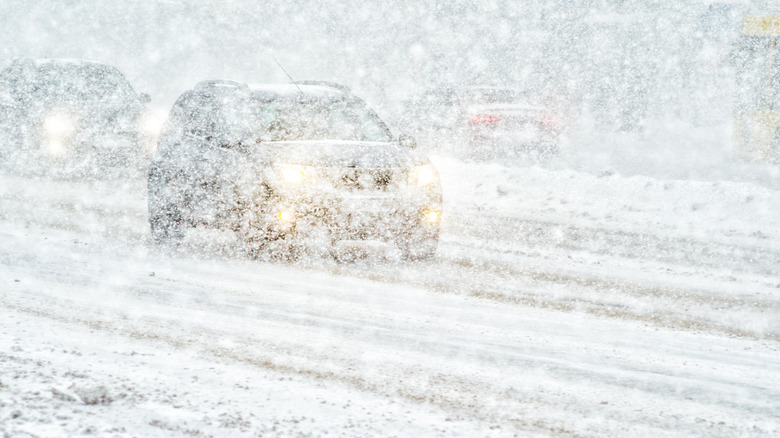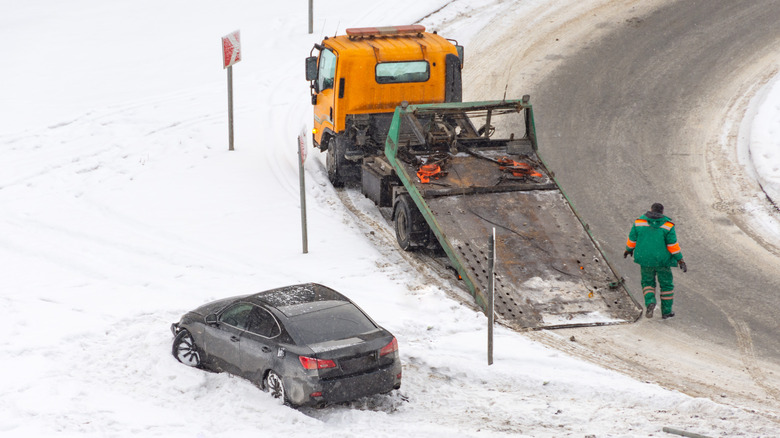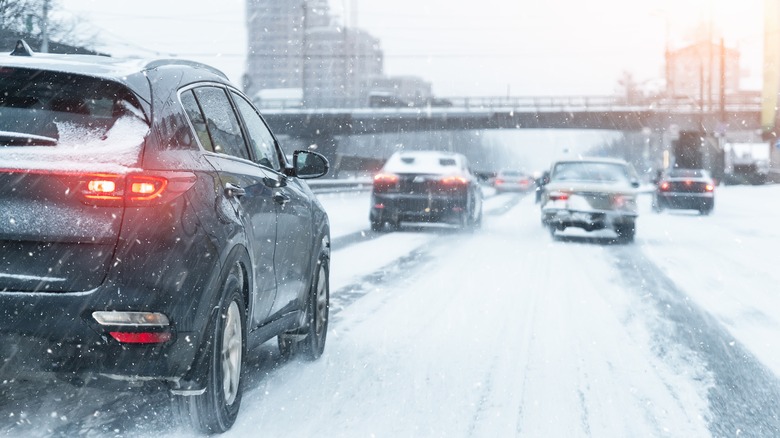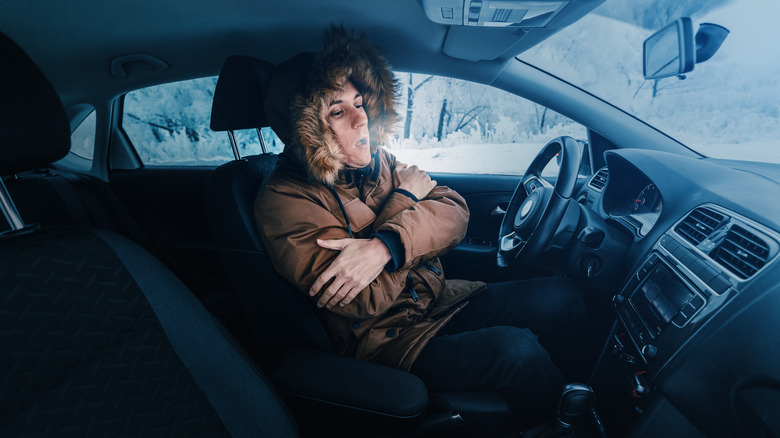12 Tips For Staying Safe When Traveling In The Snow
Road trips — and traveling in general — can be stressful even under normal circumstances. When you add frosty weather and winter warnings, the daunting task of navigating through the snow and ice can be downright terrifying. Whether there is a light dusting on the roads or a full-on blizzard, driving in the snow is dangerous even for experienced drivers. But you can lessen the risk of traveling in the snow by preparing and understanding some basic tips on how to make your journey as safe as possible.
The number one tip for staying safe in severe weather would be to not attempt to travel. There are circumstances, however, that may require you to traverse the snow even if you would rather be snug at home under a blanket. And although you might not start a journey in bad weather, it's possible bad weather may meet you out on the open road — so it's best to understand what steps to take to keep yourself (and any passengers) as safe as possible.
Pack an emergency bag
Any time you are planning to travel a significant distance, you should plan for the worst and have some kind of "just in case" pack in your car. As it is more dangerous to drive in bad weather, when your car has more of a chance to skid on the road, you're going to want to make sure you have some emergency supplies in your car.
While you may take every precaution on this list to keep from having an accident, they can be unavoidable — they aren't called accidents for nothing. That's why you should be prepared for the event that you slide or get pushed off the road. Most car owners keep handy items like jumper cables and a car jack in their car for emergencies, but keeping a more extensive emergency pack in your car, especially if you're planning on a long car ride, could be incredibly beneficial.
Keeping simple and affordable items — a glass breaker in your car, for example, in case you need to bust the window in order to exit your car, and something bright to tie onto your antenna to make your car more visible to traffic — are small objects that don't take up a lot of room but that you'll be grateful for if you ever need them. Flares are also a great addition to your car, as they can last pretty much forever, work in the snow, and are universally seen as a sign of distress.
Avoid traveling at night
Traveling in the snow is already going to be one complication that requires all of your attention; you're not going to want to add darkness and loss of visibility to the unmanageable task at hand. Road tripping at night comes with a whole slew of its own dangers, but using headlights in the snow decreases visibility – the lights reflect off the falling snowflakes and the snow already on the ground.
Not only is it more dangerous to travel at night while already navigating the snow because of visibility changes, but it also naturally gets colder at night and may refreeze any snow that has melted, making ice a very real hazard. Even if you could see perfectly, ice on the road is practically invisible and unavoidable.
Not being able to see the road — combined with unpredictable road conditions — is a dangerous mix. And once you add drowsiness that can come with late hours it's pretty much a recipe for disaster. If you can keep your road travel to daylight hours, you will avoid one risk that is likely not worth taking.
Avoid traveling alone
If you can avoid traveling in the snow, absolutely do it. If you can't, try to at least avoid traveling in the snow alone. Traveling solo has plenty of benefits, but traversing a snowy road alone isn't one of them. If you can travel with someone who has more experience than you driving in the snow, it may be best to let them drive as well.
Not only will you be able to share driving time with another person and give each other breaks from the high-demand winter driving, but you will have at least one other person to help if anything were to go wrong with your car or if you get stuck in the snow. Being stranded in the snow alone is scary — it's much less so with company.
The only downside to having another person in the car with you is an added distraction, so it's important that whoever is a passenger in the car is respectful of the attention that goes into driving in the ice and snow. Still, the benefits of traveling with another person rather than traveling solo are so great that it likely outweighs the danger a potential distraction would be.
Share your location
Even if you are able to rope someone else in to take a snowy road trip with you and are not driving alone, it is an incredibly smart move to share your location with your loved ones and keep them informed of your movements. Letting them know when you depart, your ETA, and when you arrive can be vital in maintaining your safety, as someone outside of your traveling group will be able to calculate if something could be wrong.
Bonus points if your traveling partner(s) share their locations as well. If everyone in your traveling party lets the people in their lives know their plans and location, there is more of a chance that someone will notice if your group is not where you should be or if your location has stopped moving for any significant length of time.
There are a number apps and tools you can use to passively update your locations, like Find My Friends and Life360. You can also use Google Maps to quickly share your live location with your contacts. If you don't like the idea of data sharing, a good old fashioned phone call can do the trick, too.
Keep your car maintained
Before starting out on any road trip, you should get your car checked out and make sure it is up to date on any regular maintenance and whether it needs long term things fixed. You should be starting out with all your fluids topped off and all your lights working and cleaned so that you will have as much visibility as possible, both for you seeing the road and so that other cars can see you.
If you already know you are likely to be getting snow during your trip, double check that your tires and brakes are in good condition. If the tread on your tires has worn down significantly, you are going to want to replace them for ultimate safety. You should have fully functioning windshield wipers with good blades as well. These quick and simple checks will set you up for a successful road trip and help keep you as safe as possible in bad weather.
Winterize your car
While you may be caught up unawares in the snow during an ongoing trip, chances are you may be aware that snow has a good possibility for when you are planning on traveling, or you may be going to a destination that is typically snow-covered. If there is a chance you may be doing a good amount of driving in the snow, it's a good idea to winterize your car, and getting snow tires is a great way to do that. Snow tires are specifically made to withstand the harsh environment that winter and freezing temperatures bring with it, whereas all-season tires have significantly less traction in snow and slush.
If you are someone who tends to let your gas tank hover near empty, you should temporarily change this habit while traveling in the snow. Keeping your gas tank from dropping below the half-way mark in snowy conditions can prevent you from running out of gas in less-than-ideal road conditions and can also prevent too much moisture from forming in a less full tank, which can lead to rust. Installing more heavy duty, winter specific windshield wipers can also help keep your windshield clear of ice.
Know how to manage slides
When there is snow or ice on the road, practically everything has the potential to be a hazard. The majority of the time, you can't really see what is ice and what is slush or simply just road, so it's best to treat the entire road as if it is covered in ice. Hitting a patch of ice and your car reacting to it can be managed, but only just slightly managed. Knowing how to control your vehicle when it is nearly uncontrollable could save not only you and the people in your car, but the people you are sharing the road with as well as any pedestrians in the car's path.
The most important thing to remember when your car starts to skid — and it is likely to skid occasionally when driving in snowy conditions — is to remain calm and absolutely not panic. You need to be clear headed, because your first instinct is going to be to either over-correct with the steering wheel or hit your brakes. You're not going to want to do either of these, but instead to kind of let the slide take you and slightly correct when you feel it give a little. Trying to take back control from the slide will send your car into tailspinning chaos.
Do not decrease or increase speed quickly when driving in the snow or ice. You're going to want to use your brakes sparingly – driving in a lower gear can help with this.
Take it slow
Since slides are pretty much a sure thing when driving in snowy conditions, a big part of managing a slippery road is to slow it way down. While you should consider the speed limit of the area you are driving in as a guideline, taking it slower than the marked speed limit is not only smart, but typically vital to your safety. Speed limits are marked at peak road conditions, not the most hazardous ones. In fact, it's a general recommendation that your speed should be around half of the posted limit in snowy conditions.
Taking skids at a lower speed is a lot more manageable than sliding quickly, and when cars are reckless on the road when snow and ice are present they put everyone on the road at risk. Not only is it more likely that you will lose complete control of your vehicle if you are not driving cautiously, but you won't be able to brake during a slide and will possibly increase in speed. Plan to extend your travel time exponentially when driving in winter conditions, because you do not want to be in a rush on snow-covered roads.
Invest in roadside assistance service
It's wise to hope for the best, but plan for the worst. In planning for a car malfunction or getting stuck in snow on the side of the road, it's a smart move to join a roadside assistance subscription like AAA. That way, you shouldn't be stuck long and it will be easier to either get back on the road or get somewhere warm quickly.
While AAA does not have the capability to help snowed-in cars or cars that are not readily accessible to their tow trucks, they likely will be able to tow a car that is broken down on the side of the road or help you get out of a snowy ditch. Even if you end up not needing a tow or assistance, knowing that you have a plan if something were to happen on the road can bring some much appreciated peace of mind in an otherwise stressful traveling situation.
Though you can use most services as soon as payment for the membership is made, check with whichever service you sign up for if there is an established timeline of services. You may need to sign up for membership a few days to a week before your trip to make sure all services would be available to you if something were to happen on your road trip.
Stay away from other cars
Okay, so there are bound to be other cars on the road, even if the recommendation is to not travel in bad weather unless you absolutely have to. While you won't be able to avoid other people on the road entirely, it's best to treat any other vehicles with a certain amount of wariness. As a driver, you likely understand how hard it is to control a vehicle in snow and ice. Slides are near-impossible to control while they are happening and we've already established that they will most likely be happening if snow is on the ground — and not only will they happen to you, but everyone else on the road as well.
With that in mind, it's not a far leap to consider everyone on the road has the same semi-unreliability when operating a huge machine under less than desirable circumstances. A bunch of people sharing space with automobiles they don't have 100% control over is not an ideal situation.
Following distances should be increased when driving in the snow, and you should be looking out for scenarios in which cars in the other lane may skid over into your lane — and watch for potential accidents from cars around you. Also look out for pedestrians and how your car will react to obstructions, because a slide could potentially take you off the road and into pedestrian territory. Parking lots are especially dangerous in this way.
Keep your phone charged
Luckily, we live in an age where communication is easier than it ever has been — but you actually need a functioning phone for it to matter. It's incredibly important to have your phone as fully charged as possible at all times when you are traveling, and it's not just for the scenic pictures and travel selfies. You never know when you may run into a problem on the road and having a phone available to call for help is a valuable resource.
You should definitely have a car charger and keep your phone hooked up to it while you are driving, especially if you are running a high-energy app like navigation. Investing in a portable power bank that is compatible with your charger isn't such a bad idea either, as you will be able to keep your phone charged even if your car dies.
Even if you start out your journey with a full battery and are used to your phone lasting quite a while without getting low in a charge, you'll need to check it sporadically if it's not actively charging. There are quite a few service dead zones throughout the United States, and struggling for service can drain your battery. Using airplane mode can help preserve your battery life, as well as turning on power save mode.
Keep your car stocked for winter driving
If you follow all these safety tips and still somehow end up on the side of the road stuck in thick snow or slippery ice, all hope is not lost. Keeping a small hand shovel and a couple bags of sand when you're planning to do some driving in bad weather is a great idea, especially if you have a car without all wheel drive. When placed around your tires that are stuck in the snow, sand can help your car gain traction and get unstuck.
Having sources of warmth available in case you get stranded is a great idea as well — a couple blankets, a winter outfit with gloves and a hat, and even some hand warmers come to mind. In fact, keeping these stored in your car throughout the winter isn't such a bad idea either. Storing drinking water as well as non-perishable food that can easily be opened can also offer some comfort, as you won't be going thirsty or hungry if stranded for an extended period of time. While not likely, it could happen in particularly bad weather.
